Do you have a question about the Ricoh SP C260DNw and is the answer not in the manual?
Introduces names and functions of machine parts.
Details the external front components and their numbering.
Details the external rear components and their numbering.
Shows internal components and their numbering.
Describes the buttons and indicators on the control panel.
Explains how to install optional components like the paper feed unit.
Explains the steps for loading paper and setting sizes/types.
Details how to load paper into trays and bypass tray.
Provides instructions and precautions for loading envelopes.
Explains how to set paper type and size via the control panel.
Details the steps to specify the paper type using the control panel.
Details how to specify the standard paper size via the control panel.
Details how to specify a custom paper size via the control panel.
Explains setting paper type and size using the Web Image Monitor.
Explains how to set paper type and size using the printer driver.
Lists supported paper types, sizes, and specifications for each tray.
Details specifications for various paper types like Plain, Middle Thick, etc.
Lists paper types that should not be used with the machine.
Provides guidelines for proper paper storage to prevent issues.
Illustrates the printable area on paper and envelopes.
Describes duplex and combined printing features.
Explains settings for bidirectional communication and manual setup.
Guides on accessing printer settings from Start Menu or applications.
Explains the fundamental steps for printing a document.
Provides solutions for errors related to paper size or type mismatches.
Explains how to cancel print jobs from the control panel or computer.
Explains the Locked Print function for password-protecting jobs.
Details how to print photos directly from a PictBridge-compatible camera.
Mentions support for Mopria printing and provides a URL.
Describes various print quality and output functions available.
Explains using Windows ICM for color reproduction.
Covers collating, orientation, multiple pages per sheet, and duplex printing.
Explains how to prevent blank pages from printing.
Describes adding a cover page to print jobs.
Details how to print using non-standard paper sizes.
Explains how to add watermarks to printouts.
Explains basic navigation and operation of the control panel.
Lists parameters included in each menu accessible via the control panel.
Details settings for paper size and type for each tray.
Explains how to print configuration pages and test pages.
Covers settings for color density, toner notification, and humidity control.
Configures auto continue, copies, paper size, duplex, and energy saver settings.
Configures timeouts, network settings, IPsec, and Wi-Fi.
Sets page orientation, font, and symbol sets for PCL printing.
Configures resolution and color profiles for PostScript printing.
Allows changing the display language of the control panel menu.
Lists functions configurable remotely via Web Image Monitor.
Guides on accessing and using the Web Image Monitor interface.
Explains how to access and navigate the Web Image Monitor top page.
Describes how to change the language of the Web Image Monitor interface.
Shows how to check machine status, toner levels, and component life.
Details configuration of tray paper settings, priority, and bypass tray behavior.
Configures timeouts for USB, Locked Print, and Fixed USB Port.
Controls color toner consumption for B&W printing.
Explains how to set up user codes to restrict access to specific functions.
Details how users are authenticated for restricted functions.
Guides on setting up Ethernet and Wi-Fi connections and network protocols.
Details IPv6 address and configuration settings.
Configures network printing protocols like IPP, FTP, RAW, LPR.
Configures DNS server settings for name resolution.
Sets up email alerts for machine events like paper misfeeds or toner low.
Configures SNMP services for network management.
Configures settings for sending email via SMTP.
Configures settings for receiving email via POP3.
Configures wireless LAN connection settings like SSID, authentication, and encryption.
Configures Wi-Fi Direct connection parameters.
Guides on configuring IPsec for secure network communication.
Details how to configure IPsec settings on a Windows computer.
Explains how to enable/disable IPsec directly from the machine's control panel.
Explains how to print various reports and configuration lists.
Covers setting passwords, resetting configurations, and managing backups.
Explains how to configure Energy Saver modes 1 and 2.
Sets the mode for PCL6 printing.
Provides step-by-step instructions for replacing the print cartridge.
Guides on how to replace the waste toner bottle.
Covers replacement of Intermediate Transfer Unit, Fusing Unit, and Transfer Roller.
Outlines safety precautions and general cleaning guidelines for the machine.
Explains how to clean the toner density sensor when prompted.
Details how to clean friction pads and paper feed rollers to prevent misfeeds.
Guides on cleaning the registration roller and paper tray to improve print quality.
Provides cautions and procedures for safely moving the machine.
Explains common messages and recommended actions for control panel alerts.
Explains the meaning of various indicator lights on the printer.
Provides solutions for different types of paper jams.
Offers solutions for problems preventing test page printing.
Addresses issues like smooth feeding, jams, wrinkles, and curled paper.
Helps diagnose and resolve issues affecting print quality.
Guides on checking and adjusting printer driver settings to fix print issues.
Covers issues like errors, canceled jobs, and slow printing.
Addresses issues like blurred printouts, smudged toner, and white lines.
Solves problems related to paper feeding, stacking, and curling.
Covers issues when toner runs out or printing stops.
Addresses common issues like the machine not turning on or strange noises.
Details connecting the machine to a network via USB or Ethernet cable.
Explains methods for connecting to a wireless network using Wi-Fi setup, WPS, or PIN.
Explains the IPsec protocol for secure network communications.
Details the encryption and authentication functions within IPsec.
Explains Security Association (SA) settings for IPsec.
Outlines the procedure for specifying encryption key exchange settings.
Details how to configure IPsec settings on a Windows computer.
Explains how to enable/disable IPsec directly from the machine's control panel.
Provides important notes regarding toner usage and replacement.
Lists general specifications, power requirements, dimensions, and weight.
Details printing speed, resolution, interface, and languages.
Lists specifications for the optional paper feed unit.
Lists consumable items like print cartridges and their average page yields.
Details the waste toner bottle capacity and replacement recommendations.
Contains environmental and regulatory information for specific regions.
Explains the ENERGY STAR program and its requirements for energy efficiency.
Details the machine's energy saver modes and power saving features.
Provides specifications for Energy Saver modes and duplex function.
Lists trademarks and copyright information.
| Printer Type | Laser |
|---|---|
| Print Technology | Laser |
| Color Capability | Color |
| Print Resolution | 1200 x 1200 dpi |
| Monthly Duty Cycle | 30, 000 pages |
| Connectivity | USB, Ethernet |
| Mobile Printing | Yes |
| Paper Capacity | 250 sheets |
| Duplex Printing | Yes |
| Network Ready | Yes |
| Wireless Networking | Yes |
| Toner Cartridges | Black, Cyan, Magenta, Yellow |
| Operating System Compatibility | Windows, macOS, Linux |
| Paper Size | A4, A5, B5 |
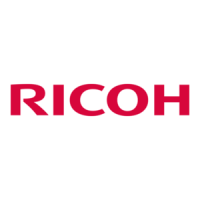

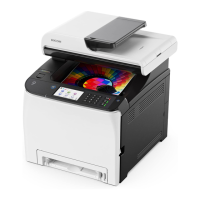

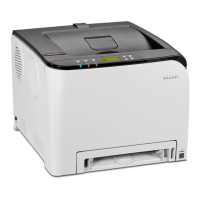

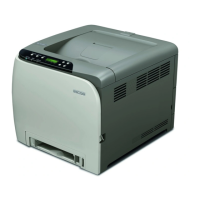



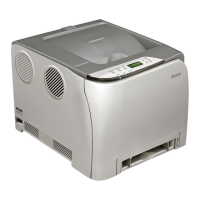
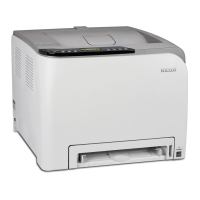
